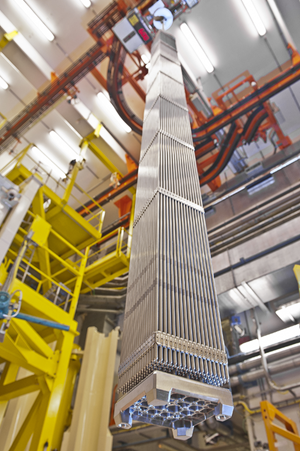
Nuclear fuel: the key takeaways
Nuclear fuel plays a crucial role in the generation of low-carbon electricity. Unlike fossil fuel power plants which need to burn coal, fuel oil or gas to produce energy, nuclear power plants use nuclear fuel to provide electricity. Much more than a simple raw material, this fuel represents a source of sustainable and responsible energy for future generations. Learn about the specific properties and advantages of these high-tech assemblies which actively contribute to the safety of nuclear reactors.
Nuclear fuel: a sustainable energy source for the production of electricity
Acting as the primary source of energy for nuclear power plants, the fuel is either made up of enriched natural uranium or recycled materials in the form of cylindrical pellets.
The process used to fabricate nuclear fuel is critical to guaranteeing its efficiency in a reactor. The pellets, usually with a diameter of 7 to 8 millimeters and weighing just under 7 grams each, are housed in zirconium alloy metal tubes around 4 meters long, and sealed at each end to form rods. The choice of zirconium guarantees high resistance to corrosion by water. It’s widely utilized to clad the fuels used in all types of light water reactor.
The rods are then grouped together to form fuel assemblies. Acting as a powerful energy battery, they are then placed in the core of the reactor to trigger the electricity production process.

The different types of nuclear fuel
Each nuclear fuel has unique characteristics and meets specific needs adapted to each type of reactor in the generation of electricity. Here we focus on the three main types: UOX fuel, MOX fuel and thorium, and the development of HALEU fuel which will be essential to power the next generation of reactors.
UOX fuel: the benchmark for nuclear energy
UOX (Uranium OXide) fuel is most commonly used in pressurized water reactors (PWR) and boiling water reactors (BWR), which are the principal reactors used worldwide. This type of fuel is made from natural uranium, enriched to increase its proportion of
fissile uranium-235.
Uranium dioxide (UO2) pellets are carefully stacked in zirconium alloy tubes to form fuel rods.
When used in a reactor, UOX fuel produces energy through nuclear fission and also generates plutonium during the cycle. At the end of its
life, approximately 30 to 40% of the energy produced by the spent fuel comes from the fission of plutonium, which still makes up 1% of the spent fuel.
What are fuel assemblies made up of?
Mox fuel: nuclear processing - recycling
France is known for its “closed cycle” approach, where spent fuel is processed and recycled to optimize waste management and recover 96% of reusable materials: 95% reprocessed uranium (URT) and 1% plutonium. The plutonium extracted is mixed with uranium oxide to produce a new fuel, Mox.
Currently, around 10% of the nuclear electricity generated in France is produced using Mox.
Did you know?
Just 1 g of plutonium (which is equivalent to 100 g of uranium), represents the energy equivalent of more than 1 metric ton of oil!
Thorium: a promising alternative
Although less commonly used than uranium, thorium is a potential alternative for nuclear reactors. This material can be transformed into fissile uranium-233 in the reactor core. Unlike uranium, use of thorium produces fewer minor actinides and no plutonium, reducing the challenges linked to long-term management of nuclear waste.
India, China, the United States, Russia and several European countries are interested in the development of the thorium sector, with industrial maturity expected within 20 to 30 years.
HALEU fuel: a response to the challenges of advanced reactors
HALEU (high-assay low-enriched uranium) fuel is essential for the next generation of nuclear reactors and small modular reactors (SMR/AMR). It offers advantages in terms of efficiency and energy security. With its higher energy density, more energy can be produced with less fuel, thus reducing reactor size and extending fuel life.
However, producing HALEU in sufficient quantities poses a major challenge. The European Union estimates that it will need 700 to 1000 kg of HALEU per year for its research reactors by 2035.